
Dalian Zhoushuizi International Airport is an international airport serving the city of Dalian in Northeast China’s Liaoning province. It is located in Ganjingzi District, about 10 km (6.2 mi) northwest of the city center. In 2018 the airport handled 18,758,171 passengers, making it the busiest airport in Northeast China and the 24th busiest nationwide. The airport is the hub for Dalian Airlines and a focus city for China Southern Airlines and Hainan Airlines. As Zhoushuizi Airport has reached its designed capacity, the new Dalian Jinzhouwan International Airport is being built on reclaimed land to replace it.
China United Airlines Co., Ltd. is a low-cost carrier and a subsidiary of China Eastern Airlines with its headquarters and main hub on the grounds of Beijing Daxing International Airport in Daxing District, Beijing, operating scheduled flights and charter services in co-operation with local enterprises out of Daxing Airport. In 2019, China United Airlines' painted aircraft won TOP.01 at the World Classic Aircraft Award.
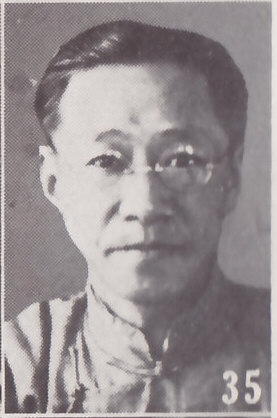
Weng Wenhao was a Chinese geologist and politician. He was one of the earliest modern Chinese geologists, and is regarded as the founder of modern Chinese geology and the father of modern Chinese oil industry. From May to November 1948, Weng served as President of the Executive Yuan (Premier) of the Republic of China.
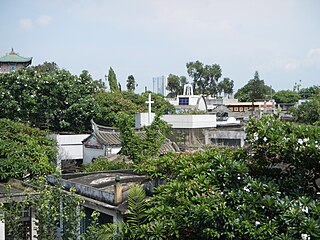
The Manila Chinese Cemetery is the second oldest cemetery in Manila after La Loma Cemetery. The cemetery includes Christian, Buddhist and Taoist burials. The present-day cemetery is a vaguely trapezoidal area of about 54 hectares with an irregular network of roads its old pre-war part along Rizal Avenue Extension, reflecting its gradual evolution and expansion. Meanwhile, the post-war portion has three major roads bisected by minor roads, aligned NW to SE. Matandang Sora, coming from the main entrance in Felix Huertas going towards Chong Hock Temple, is the main road today. Before the Pacific War the main entrances faced Avenida Rizal. This northwestern is the oldest and most historically significant part of the cemetery. The cemetery was witness to many executions during World War II. Among them were Girl Scouts organizer Josefa Llanes Escoda, Filipino Brigadier General and hero during World War II and Boy Scouts of the Philippines charter member Vicente Lim, literary geniuses Rafael Roces and Manuel Arguilla, star athlete-turned-guerrilla spy Virgilio Lobregat, and Chinese Consul General Yang Guangsheng. Apolinario Mabini was also buried in the cemetery before his remains were transferred to Batangas on July 23, 1956.
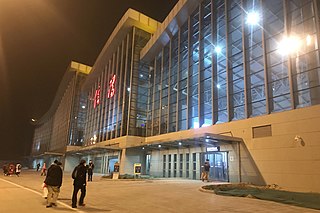
Xinyang Minggang Airport, or Minggang Air Base, is a dual-use civil and military airport serving the city of Xinyang in Henan Province, China. It is in the town of Minggang in Pingqiao District, about 45 kilometres (28 mi) from downtown Xinyang and 48 kilometres (30 mi) from the city of Zhumadian.
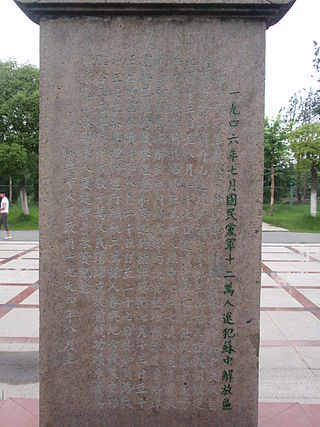
Zhong'anlun Monument is a memorial monument dedicated to the victims of the Yangtze ferry disaster that occurred in October 1945, during the Chinese Civil War. Opened in October 1987, it is located in the Taixing Park on the north side of Taixing City in Taizhou, Jiangsu province.
Shangqiu Airport, or Shangqiu Air Base, is a military air base near the city of Shangqiu in China's Henan Province. It is located in Guantang Township, Liangyuan District, 16 kilometres (9.9 mi) west of the city center. The airport was built in the 1930s and was known as Gui'deAirbase, and served in national defense operations during the Sino-Japanese Conflict, and the planning is to convert the air base into a dual-use military and civil airport with an estimated investment of 500 million yuan. The airport is expected to serve 300,000 passengers and 1,000 tons of cargo per year by 2020.

Heroes of the Eastern Skies, is a Chinese war drama filmed in Taiwan, R.O.C. and based on the true story of a small group of Chinese flying aces in 1937 at the beginning of the Second Sino-Japanese War, specifically depicting events in the Battle of Shanghai, Battle of Nanking and the Battle of Taierzhuang; the movie was released on 7 July 1977 in commemoration of the 7/7 Incident which sparked the start World War II in Asia.

Hunan Martyr's Park is an urban park and the largest park in Changsha, Hunan, China. Covering an area of 343.3-acre (138.9 ha), the park was constructed and opened to the public in 1953. It is a renowned scenic spot integrating memory, leisure and tourism. Hunan Martyr's Park has been designated as a "Provincial Key Cultural Protection Unit" by the Hunan government and a "National Patriotic Education Base" by the Publicity Department of the Communist Party of China. In 2009 it was categorized as a "National Key Park" by the Ministry of Housing and Urban-Rural Development.

The Memorial Hall of the War to Resist US Aggression and Aid Korea, also translated as the Korean War Museum, is a museum in Dandong, Liaoning. It is the only official museum in China that memorializes the Korean War. First established in 1953, it was rebuilt at its current location in October 1990. The new museum was opened on 27 July 1993, the 40th anniversary of the Panmunjom armistice. Since 2014 it has been closed for refurbishment. It was reopened on 9 September, 2020.
Nanchang Qingyunpu Airport, also known as Sanjiadian Airport, is an airport in Qingyunpu District of Nanchang, Jiangxi, China. Originally constructed for use by the Republic of China Air Force, it was the largest airport in China when opened in 1935. The airport was destroyed during the Second Sino-Japanese War and rebuilt afterwards. After 1949, it was mainly used for test flights by the aircraft manufacturer Hongdu Aviation Industry Group, until its replacement by Nanchang Yaohu Airport in 2018.
Gongxingdun Airport also called Lanzhou Donggang Airport (兰州东岗机场) was an airport in Gongxingdun township, Chengguan District, Lanzhou, Gansu, China. It was the primary airport of Lanzhou from the 1930s to 1970.
Jurong Airfield, may also be romanized as Chuyung (Cantonese), was an air force base serving in defense of former capital city of Nanjing during the Republic of China era on the mainland.
Cen Zeliu, also Shum Tsak-lau(Cantonese): was born in Enping, Guangdong, China. He trained in the Guangdong provincial aviation academy as a fighter pilot, graduating in 1934, and attached to the provincial warlord air force of General Chen Jitang. With the imminence of war between China and the Empire of Japan brewing ever since the Manchurian Incident of 1931, Cen Zeliu and his compatriots were indignant on taking the fight back to the Imperial Japanese invasion and occupation.
Zhanjiang Wuchuan Airport is an airport in Wuchuan, Zhanjiang, Guangdong, China. . The airport opened on 24 March 2022, replacing the Zhanjiang Airport in Xiashan.

Songjiang Tang Sutra Building, also known as Songjiang Tang Dynasty Dharana Sutra Stone Building, is located in the Zhongshan Primary School, Songjiang District, Shanghai, People's Republic of China, the oldest surviving above-ground relic in Shanghai, built in 859 AD. Since then, it has tilted due to age and weathering, and was restored in 1963.On January 13, 1988, it was announced as a national key cultural relic protection unit.

The 2019 Zigong earthquake occurred in Zigong, Sichuan Province, China, at about 13:00 on February 25, 2019. The epicentre was located in Rongxian County, with a magnitude of 4.9, a focal depth of about 5 km and a maximum intensity of VI. The earthquake killed two people and injured 12 others.
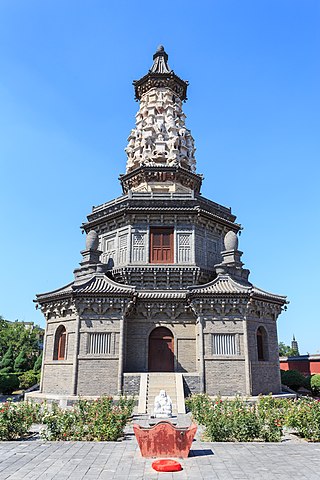
Guanghui Temple Huata,, is located on Guanghui Road, Zhengding County, Shijiazhuang City, Hebei Province, People's Republic of China, and is a 4-story octagonal Huata. The tower was built in the Tang Dynasty and rebuilt in the Dading years of the Jin Dynasty. The entire pagoda has 3 floors in the style of an attic, with steps on the first and second floors, and 2 statues of Buddha enshrined in the heart chamber of the pagoda on the third floor. The fourth layer is a bouquet-shaped pagoda statue of warriors, elephants, lions and Bodhisattvas. During the Republic of China period, the four sets of chambers below the tower were destroyed during the war. In 1961, Guanghui Temple Huata was listed as a national key cultural relic protected unit. In 1999, the repair project of Guanghui Temple Huata was completed, and the whole temple was restored to its original appearance.
Consort Zhuangyide was an imperial consort of the Ming dynasty, married to the Chenghua Emperor.
Yen Hai-Wen was a Chinese pilot in the Air Force of the Nationalist Government.














